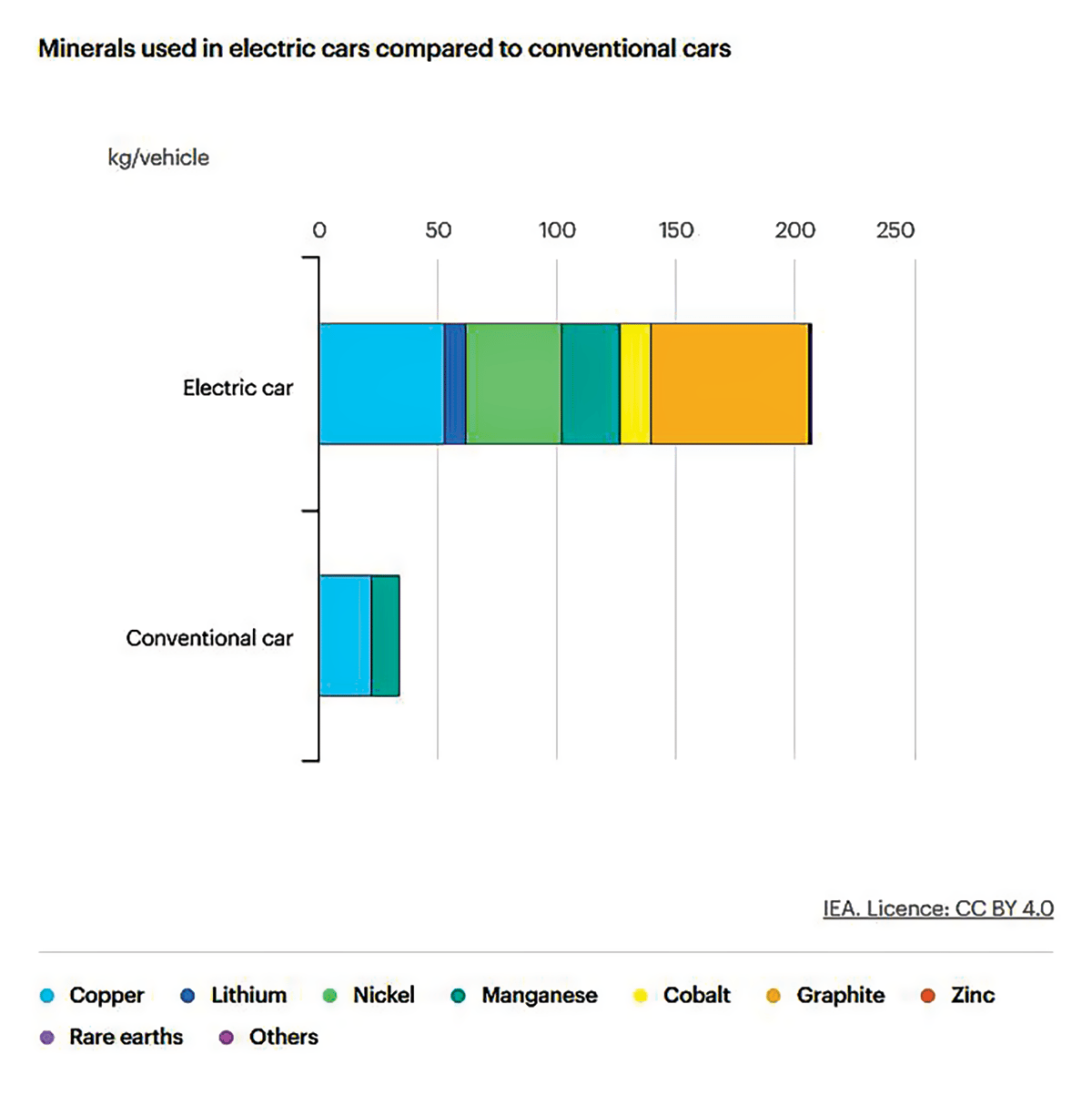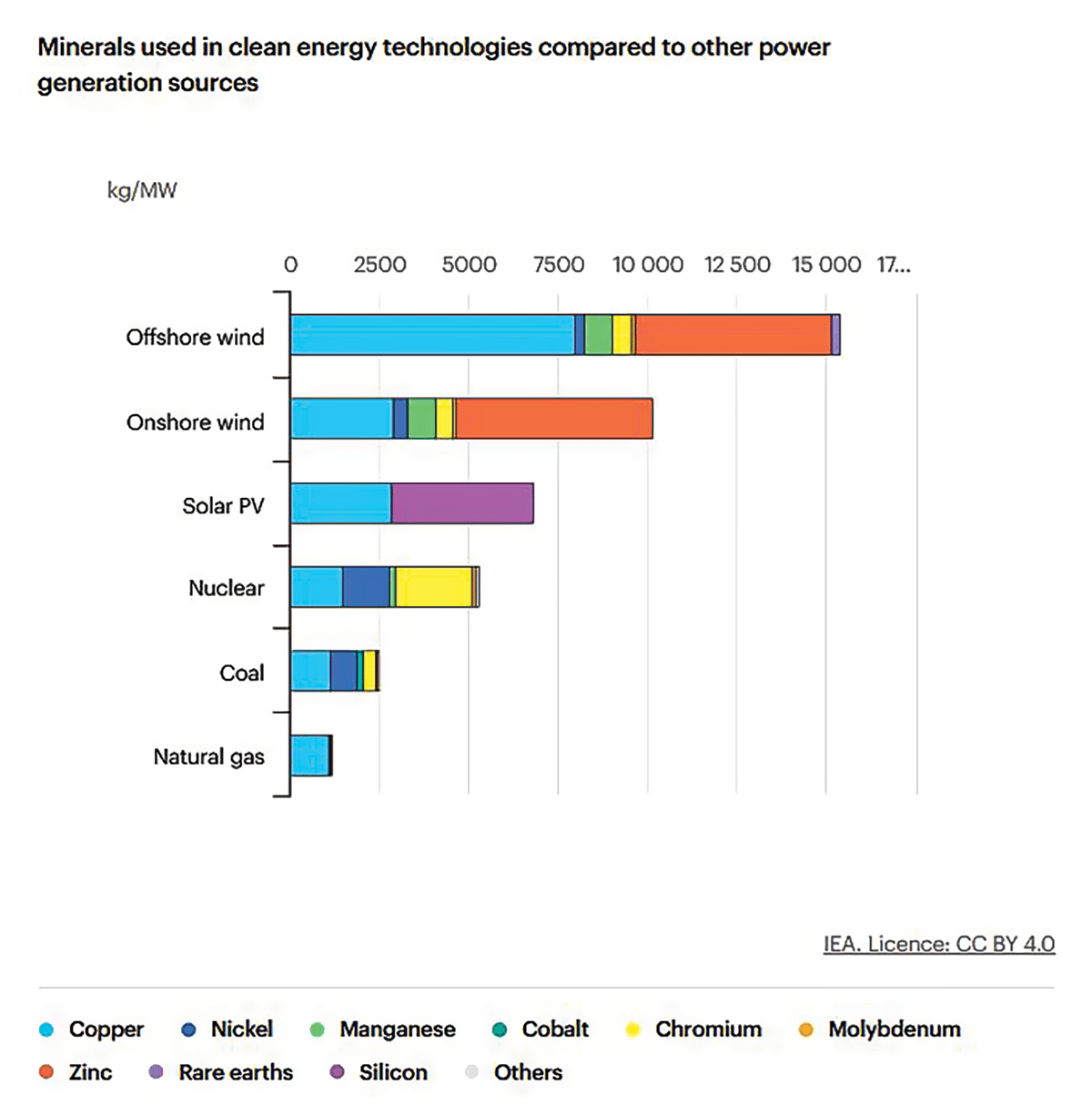bulletin | feature story
Chile and the clean energy transition
As a top producer of copper and lithium, Chile will play a critical role in the clean energy transition. But there are environmental and political obstacles to meeting the demand for these minerals.
By Lisa McDonald
Salar de Atacama, the largest salt flat in Chile and the third largest in the world. In April 2023, Chilean president Gabriel Boric announced a plan to require that private companies take Chile’s government on as a partner in the extraction of lithium.
Credit: Francesco Mocellin, Wikimedia (CC BY-SA 3.0)
The clean energy transition will require unprecedented amounts of minerals.1 Chile will be a critical player in meeting this demand.
Mining is one of Chile’s key economic sectors, accounting for 11% of the country’s GDP and more than half of the country’s total exports.2 Among the minerals it produces, Chile is known as the top copper producer in the world and the second-largest producer of lithium,3 both key minerals in the production of clean energy technologies.
Yet as demand for these minerals surges, Chilean copper mines are struggling. In March 2023, Bloomberg reported that Chile had posted its lowest monthly production in six years.4 While there are recent factors driving this shortage—including a prolonged water drought5 and a string of operational setbacks and project delays6—at least some of the current predicament is historical.
The clean energy transition will require unprecedented amounts of minerals.1 Chile will be a critical player in meeting this demand.
Mining is one of Chile’s key economic sectors, accounting for 11% of the country’s GDP and more than half of the country’s total exports.2 Among the minerals it produces, Chile is known as the top copper producer in the world and the second-largest producer of lithium,3 both key minerals in the production of clean energy technologies.
Yet as demand for these minerals surges, Chilean copper mines are struggling. In March 2023, Bloomberg reported that Chile had posted its lowest monthly production in six years.4 While there are recent factors driving this shortage—including a prolonged water drought5 and a string of operational setbacks and project delays6—at least some of the current predicament is historical.
“U.S.-owned mines nationalized by Chilean President Salvador Allende in 1971 weren’t returned to their owners after his overthrow two years later in a military coup. Instead, General Augusto Pinochet used them to create Codelco [the Chilean state-owned copper mining company] in 1976. Democratically elected governments since then have milked the state-owned company for cash, which at times has constrained its ability to invest in projects to tap richer veins of its giant deposits,” explains a May 2023 Bloomberg article on the Chilean copper mining situation.7
To overcome these challenges, the Bloomberg article reports that left-leaning Chilean president Gabriel Boric agreed to let state-owned Codelco reinvest 30% of its profit, thereby reducing borrowing needs. Additionally, Codelco CEO André Sougarret and chairman Máximo Pacheco are looking to get projects back on track by spreading the load throughout the company, streamlining decision-making, and collaborating with consultants in areas where the company has skills deficits.
Yet Codelco recently added another project to its load that some worry will distract the company from its copper responsibilities—managing public–private lithium partnerships.
“U.S.-owned mines nationalized by Chilean President Salvador Allende in 1971 weren’t returned to their owners after his overthrow two years later in a military coup. Instead, General Augusto Pinochet used them to create Codelco [the Chilean state-owned copper mining company] in 1976. Democratically elected governments since then have milked the state-owned company for cash, which at times has constrained its ability to invest in projects to tap richer veins of its giant deposits,” explains a May 2023 Bloomberg article on the Chilean copper mining situation.7
To overcome these challenges, the Bloomberg article reports that left-leaning Chilean president Gabriel Boric agreed to let state-owned Codelco reinvest 30% of its profit, thereby reducing borrowing needs. Additionally, Codelco CEO André Sougarret and chairman Máximo Pacheco are looking to get projects back on track by spreading the load throughout the company, streamlining decision-making, and collaborating with consultants in areas where the company has skills deficits.
Yet Codelco recently added another project to its load that some worry will distract the company from its copper responsibilities—managing public–private lithium partnerships.


Credit: International Energy Agency (CC BY 4.0)
Salt flats and ore mines: Understanding lithium sources for clean energy technologies
There are two primary sources for commercial lithium extraction: salt flats and lithium-bearing ores.
Salt flats, or salars, are areas where lithium-containing saltwater from underground lakes is brought to the surface and evaporated in large basins. This lengthy process, which can take anywhere from several months to a few years to complete, leaves behind concentrated salts from which lithium carbonate can be extracted.
Lithium-bearing ores, such as spodumene, are removed from the earth and processed via crushing, roasting, and acid leaching. This process results in either lithium carbonate or lithium hydroxide.
Australia, the world’s top producer of lithium, extracts its lithium through ore mining. Chile, China, and Argentina, the next three largest producers of lithium, mainly extract the mineral from salt flats.
Regarding the clean energy transition, lithium hydroxide is better suited than lithium carbonate for producing battery cathodes because it decomposes at a lower temperature. While lithium carbonate can be converted into lithium hydroxide, doing so requires additional steps and cost. As such, even if Chile increases extraction from its salt flats, the resulting lithium carbonate is not the most sustainable option for meeting this specific demand.
Lithium carbonate is critical, though, in many other applications related to energy infrastructure. For example, as a deoxidizer in the process of industrial copper and nickel smelting and as a starting material in the production of industrial lithium-based grease.
Lithium mining in Chile
Unlike the copper industry, which Chile nationalized in the 1960s and 1970s, lithium mining in the country is done by private companies, namely U.S.-based Albemarle and Chile’s Chemical and Mining Society (SQM).
In April 2023, president Boric announced a plan to require that private companies take Chile’s government on as a partner in the extraction of lithium. These public–private partnerships, which would honor existing contracts, would be coordinated by Codelco and state-owned mining company Enami until a national lithium company is created.
This framework for managing lithium projects contrasts with the setups in neighboring Bolivia and Argentina, which together make up the so-called Lithium Triangle. Collectively, these three countries host nearly 60% of the world’s known resources of lithium.8 Chile’s approach falls in between the models of Bolivia, in which the state has full control of the lithium sector, and Argentina, in which the state simply grants concessions for companies to operate.
A Reuters article reports that Albemarle and SQM have both held preliminary meetings with Chile’s state development office about the new lithium framework.9 However, while SQM signaled it plans to begin serious negotiations soon for its contract, which expires in 2030, Albemarle signaled it will not begin negotiations until closer to its contract expiration in 2043.
In response to concerns about its new lithium role distracting from copper management, Codelco says it will not divert resources from other areas to lithium, according to the May 2023 Bloomberg article.7 However, its temporary role as mediator in the public–private partnerships may be extended if the planned national lithium company is not established before the upcoming 2025 presidential election, “as some candidates could offer a different vision for the country’s lithium,” according to a report from the Eurasia consultancy, per Reuters.9
It is evident that Chile’s ability to meet the minerals demand will take a dedicated effort from both private and public entities to harness the country’s reserve of natural resources. The initiatives described above, if they come to fruition, should ideally help meet this demand.
AUGUST 2023 • VOL. 102, NO. 6

